How does your guitar affect vibrato playing? In this article, I’ll reveal all the ways that your guitar and how it’s set up can make a difference in your vibrato execution, tone, and sustain!
Keep on reading to learn more!
You can use the table of contents below to take you to the area that interests you. Click on the little box to open it and then click on the section of the article you want to read, or you can read from start to finish if you want the full vibrato experience!
The Short Answer
Your guitar’s string gauge, neck, body, electronics, hardware, and setup can all make a difference in the way you execute vibrato and change the characteristics of its tone and sustain. You may need to adjust how you play vibrato after switching guitars, making a pickup selection, or adjusting the instrument’s volume and tone controls.
Keep On Reading (Below) To Learn More
What Is Vibrato?
Vibrato is a popular technique used by virtually all string instrument players, not just guitarists. It changes the pitch (frequency) of a note or chord by making it rise up and drop down.
Vibrato can be done from the forearm, wrist, fingers, and whammy (vibrato) bar. Creating sounds below the pitch of the original note requires the use of a whammy bar, which is connected to the vibrato bridge of an electric guitar.
It gives the notes a more “singing” quality that makes them sound more natural because it mimics the vibrato of a singer’s voice.
Vibrato is also used to highlight particular notes in a musical passage to build interest and excitement. For example, Blues, Rock, and Metal players use vibrato to create an “edgy” sound.
How A Guitar Can Affect Vibrato

Here are the parts and characteristics of a guitar that can affect the execution, sound, and sustain of vibrato.
You can click on any of the items to learn more.
Keep On Reading (Below) To Learn More About Each Topic
Guitar Setup Pros And Cons For Vibrato
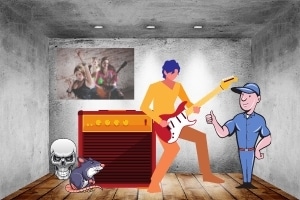

String gauge, action, and bridge type all need to be taken into account when buying and setting up a guitar to get the string bending and vibrato that works best for you.
You can click on each of the three categories to learn more.
| Item | Pros | Cons |
|---|---|---|
| String Gauge | ||
| Lighter | Vibrato easier | |
| Heavier | Vibrato harder | |
| — | — | — |
| Action (string height) | ||
| Low | Vibrato easier | May get string buzz |
| High | Vibrato sustains longer | Vibrato harder |
| — | — | — |
| Bridge Type | ||
| Fixed | Vibrato less likely to affect tuning | Vibrato width limited |
| Vibrato (Whammy bar) | Faster and wider vibrato possible | Vibrato can affect tuning |
Keep On Reading (Below) To Learn More About Each Topic
Guitar Neck
There are several ways the guitar neck can affect the performance and sound of vibrato. You may have to adjust your vibrato technique to accommodate each instrument if you have two or more guitars. Even two guitars of the same make, model, and year of manufacture can play and sound differently!
Nut
The size and material type of a guitar nut affect neck vibration, especially with the open (unfretted) strings.
Nuts can be made from multiple materials, including bone, plastic, graphite, and brass. In addition, guitars can have metal roller nuts, such as the Fender LSR nut, to keep the strings from binding and going out of tune.
Locking vibrato bridges come with locking nuts to prevent slipping at both ends.
Neck Size & Shape
Guitar necks come in various sizes and shapes.
The bigger the neck, the more natural sustain your vibrato will have. I have an early Jeff Beck Signature Strat with a very large “baseball bat” neck and a second-generation Beck guitar that has a shallower neck that’s easier to get my hand around but has less sustain. Still, I prefer the second-generation neck because I can get a smoother vibrato.
A neck’s overall shape can influence how a player’s left hand holds the neck when performing vibrato. Some common shapes are “C,” “D,” “V,” and “oval.” I prefer the “shorter V-shape,” like the one on my Eric Clapton Signature Strat.
So, play guitars with several different size and shape necks to find what works best for you!
Wood Type & Finish
Neck Wood Type
The type of wood a guitar neck is made of can have an impact on vibrato characteristics, such as sustain, attack, and tone. I favor the vibrato I get from maple necks more than mahogany.
Let’s not forget the fretboard wood, which can be the top of the maple neck, a maple cap, rosewood, mahogany, or Pau Ferro. These woods all vary in density and feel under the fingertips, so they also affect vibrato tone, sustain, and playability!
Neck Finish
Neck finish can affect vibrato mechanics. I find that a “slicker” finish makes it easy to do fast and wide vibrato. A higher quality finish, like those on PRS guitars, can definitely make hand movement during vibrato easier. Unfinished wood can vary in playability.
Fretboard Radius & Fret Size
Fretboard Radius
The fretboard radius (curvature) is another factor that can affect manual (left-handed) vibrato. It is determined by the circumference of a circle’s radius, where the mid-point is lined up to the center of the neck. That’s really all there is to it!
So, the bigger the fingerboard radius, the flatter the fingerboard, and vice-versa!
Therefore, the 7.25-inch fingerboard radius would be more curved than the 9.5-inch fingerboard illustrated below. Likewise, the 12-inch fingerboard radius would be flatter than the 9.5-inch radius.
Some players find it easier and more comfortable to bend strings and do vibrato on a flatter neck, and others like it more curved.
I find that a 9.5-inch fingerboard radius is a nice compromise for any playing style.
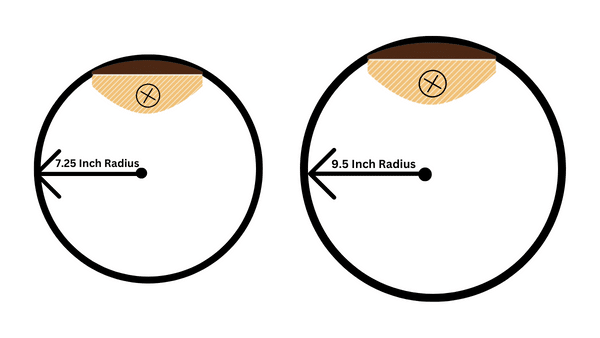
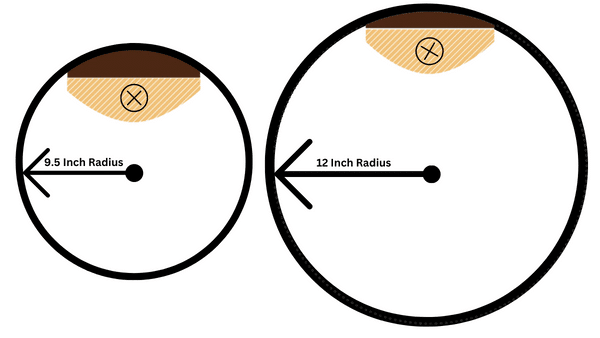
Fret Size
The size of a guitar’s frets usually goes along with the fretboard radius. For example, the earliest Fender Strat and Tele guitars had a very curved (7.25-inch) radius fretboard with narrow and low-height frets.
Many of the newer models of Fender guitars have a flatter (9.5-inch) fretboard with medium size and taller fretwire to make it easier to bend strings and do vibrato.
Metal guitars, like Ibanez and ESP, can have very flat (12 to 15-inch) fretboards and jumbo (wide and tall) frets to make things like shredding scales easy.
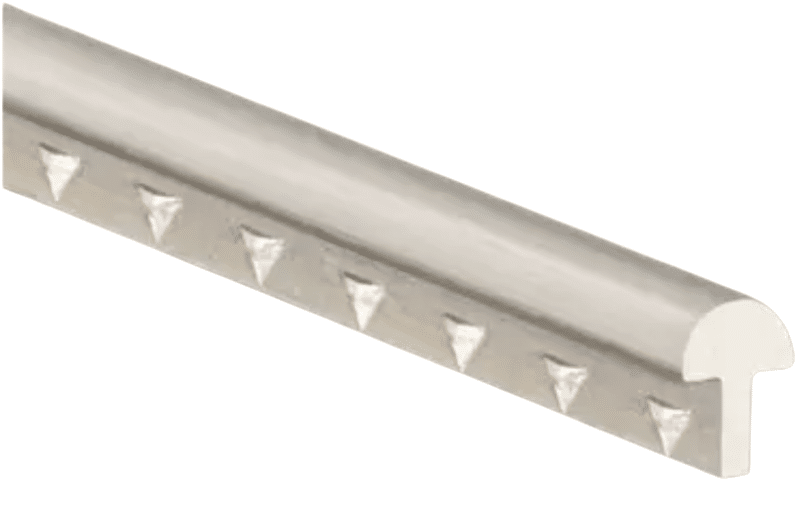
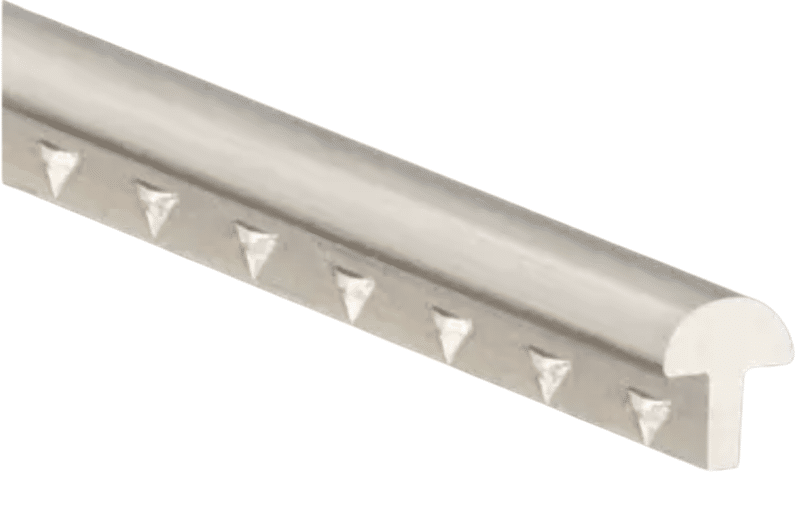
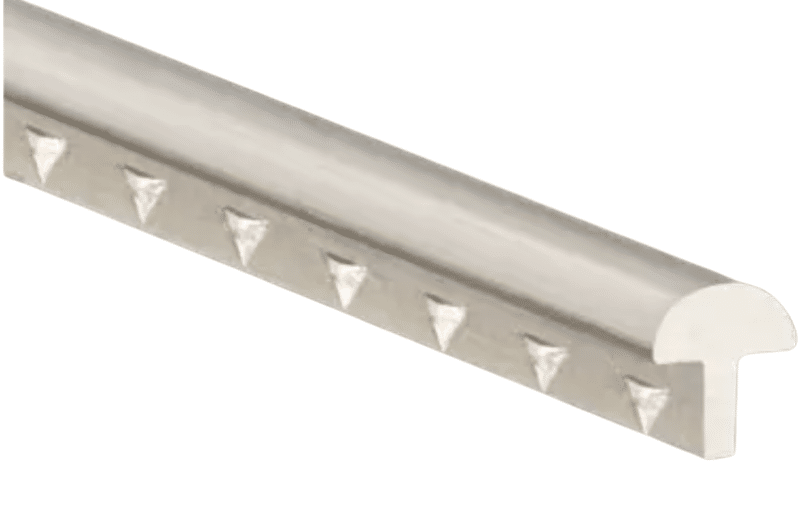
However, medium or wide frets can be installed on a curved fretboard. So, keep this in mind when you try out new guitars and select the combination that works best for you!
Scale Length
A guitar’s scale length is the distance from the nut to the bridge saddles, which is the portion of the string that vibrates. This puts the octave note to each open string halfway between this distance at the twelfth fret.
Scale length can definitely affect playing notes with vibrato because shorter scale length necks have less sting tension, making them easier to bend. Shorter scale length guitars also have frets that are closer together, which means less finger stretching.
Fender necks typically have a 25.5-inch scale length, which tends to be longer than the Gibson necks, which are mostly 24.75 inches.
The guitar’s scale length does not necessarily determine its ease of playability. For example, I find a Gibson Les Paul and SG easier to bend strings on than a Gibson Explorer because of the headstock configuration (string length), even though they all have a 24.75-inch scale length.
Neck Joint
The neck joint is where the neck attaches to the guitar’s body. Glued-in necks, like those found on most Gibson guitars, tend to vibrate the entire guitar better than bolt-on necks found on most Fender guitars.
Increased wood vibration can result in better vibrato tone and sustain.
Guitars Without A Neck Joint
This neck configuration is discussed in the “Neck Through Body Design” below.
Guitar Body
Although manual vibrato is typically performed with the fingers of the left hand and sometimes with the whammy bar, here are the ways the guitar body can affect the tone and sustain of vibrato.
Body Size & Thickness
Body size and thickness can make a real difference in vibrato tone and sustain!
For example, compare the vibrato you get from a Gibson SG to that of a Les Paul, acoustically or plugged into the same equipment. They both give you a rich tone, but the augmented thickness of the Les Paul guitar body gives you that extra natural sustain for a very even-sounding vibrato, no matter how long you try to hold the note.
Wood Type & Finish
Body Wood Type
Guitar body wood type and finish can also affect vibrato.
A wide variety of woods can be used for a guitar’s body, including alder, ash, pine, mahogany, mahogany with a maple cap, walnut, rosewood, and zebra wood.
Electric guitar bodies can also be “chambered,” with areas of wood removed internally to make the instrument lighter and modify its tonal characteristics.
Body Finish
Acoustic guitar bodies can be commonly finished with varnish and lacquer, while electric instruments can be coated with nitrocellulose and polyurethane or not finished.
The lighter the finish, the more the wood can “breathe” as it ages, which changes the way the wood resonates and the tone of the overall sound and vibrato.
There are many things to consider when choosing a guitar body. The best approach is to play it acoustically and then through a variety of amps and effect pedals to see what works best for you!
Neck Through Body Design
Some guitars do not have a neck joint. The neck is not bolted on or glued into the instrument’s body. Instead, it runs through the entire length of the body and gives the best wood vibration.
Guitars with a neck-through-body design are much thinner where the neck meets the body because it is not attached at that point. For example, this Ibanez Prestige guitar gives you excellent upper fret access, with 24 frets and neck-through-body carve-out (the best of both worlds)!

This guitar’s playability, comfort, and superior wood vibration can make vibrato a breeze with great tone and sustain!
Electronics & Hardware
The electronics and hardware on your guitar can affect the tone, sustain, and performance of vibrato on your guitar.
Tuning Machines
A low-quality or worn-out set of tuning machines can cause string slippage when bending strings and performing vibrato, especially when using a whammy bar.
Locking tuners prevent string slippage by eliminating overwinding the string on the tuning peg and string overlap.
Pickups
Guitar pickups create a magnetic string pull that can stifle vibrato. Therefore, it’s important not to place the pickups too close to the strings. Instead, find the “sweet spot” where the pickups sound best, not the loudest.
You can use your amplifier or dirt pedals like overdrive and distortion for extra volume, crunch, and lead tones.
Volume & Tone Controls
Your guitar’s volume and tone controls can make a difference in the overall sound of string vibrato.
A volume setting that is too low can diminish vibrato sustain, while the wrong tone setting can make your notes sound tinny or muddy. Players that get great clean vibrato sounds know how to adjust their volume and tone controls!
Bridge Type
A guitar’s bridge can have a significant effect on vibrato.
Fixed Bridges
Fixed bridges are found on acoustic and some electric guitars. The advantage of having a fixed bridge is that it makes it easier to get well-defined sounds when doing subtle (narrow) vibrato. A fixed bridge also adds sustain and improves the tone of vibrato because it is firmly attached at all points to the guitar’s body.
Vibrato (Whammy Bar) Bridges
A vibrato bridge can be a bit of a double-edged sword, depending on the type of vibrato you use in your playing style.
If you like to do wide vibrato that’s very dynamic, then a whammy bar can give you all this and more. For example, you can easily drop or raise the pitch of a note before adding vibrato.
On the other hand, performing aggressive vibrato with a non-locking vibrato bridge can cause tuning problems. Decked non-locking vibrato bridge setups will stay in tune better than a floating bridge.
Eric Clapton gets his particular vibrato sound by using a Stratocaster with the bridge blocked with a piece of wood and by the way he bends the strings on the fretboard.

(Eric Clapton Strat)
Related Article ➡ Floating Vs Decked Vs Blocked Tremolo Bridge – 3 Great Setups!
Bridge Saddles
The bridge saddles can affect vibrato tone and sustain, depending on the way they are set up and the material they’re made from. Saddles are available in nickel, chrome, steel, stainless steel, brass, graphite, and titanium.
The following info comes from my years of playing experience, so it’s not carved in stone. Opinions will vary among guitar players.
Brass saddles will give your vibrato a warm sound with good sustain. They usually have the warmest sound out of all the commonly used saddle materials.
Steel bridge saddles tend to be somewhere between brass and chrome in terms of sharpness or harshness of sound.
I find that stainless steel saddles tend to produce “sweeter-sounding” vibrato and harmonics than steel, all things being equal, especially on guitars with a whammy bar. This might have something to do with the cobalt concentration.
Chrome-plated bridge saddles are very hard, which can be problematic when it comes to string breakage. Nickel plating is less hard and, therefore, easier on the strings, which can make them last longer. They both sound similar with vibrato, except the chrome plating might give the tone a little more bite.
Graphite bridge saddles are great for reducing friction at the point of string contact, especially on guitars with “floating” tremolo bridges. They can help decrease string breakage but tend to give vibrato a flatter mid and high-frequency tone. Graphite saddles seem to attenuate my picking dynamics and sound a little too “one-dimensional” for my taste.
Miscellaneous Guitar Considerations
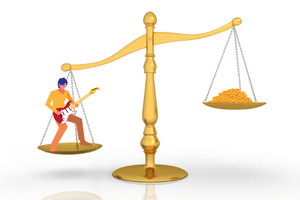
Finally, here are some of the other things that can affect the tone, sustain, and execution of vibrato on a guitar.
Guitar Setup
Your guitar needs to be set up properly to get the best vibrato. For example, too much bow or back-bow in the neck, an action that is set too low, or bridge saddle misalignment can cause intonation problems and buzzing during string vibrato.
If you don’t have the proper experience and tools to adjust your guitar’s truss rod, take it to a guitar tech or luthier to avoid permanently damaging your instrument.
String Type & Gauge
The string type and gauge can significantly affect your vibrato. For example, thicker strings will give a richer tone and longer sustain, while nickel will sound warmer than steel-wrapped strings.
Thinner gauge strings are easier to do manual vibrato because they are easier to bend.
You might be surprised how much a different brand of strings that are the same gauge and made from the same material can change your guitar’s sound due to methods of winding the outer wrap around the string’s core, etc.
If you change the strings to a larger or smaller gauge, your guitar may require a setup to make your vibrato sound best due to changes in neck tension.
Build Quality
Guitar build quality can affect a guitar’s overall tone and playability due to the quality of materials used and craftsmanship. Compare the feel and sound of vibrato on a beginner guitar to a master-built instrument, and the differences are obvious, especially in the hands of an experienced player.
Age Of The Instrument
All guitars change their tonal characteristics as they age, which can affect vibrato for better or worse.
As neck and body tonewoods age, they continue to lose moisture, especially if they are coated with a light sealer like nitrocellulose. This can give vibrato a richer tone.
Pickup magnetic field strength can diminish over time, which can be good or bad. For example, it can give jazz guitars a richer and smoother tone, while rock and metal guitars could lose their “edgy” sound and cause a volume dropout with whammy bar use.
Modifying Your Guitar Can Affect Vibrato!
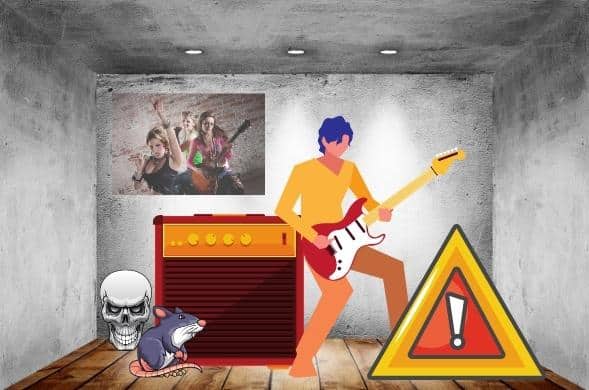
As a recap, be aware that making certain adjustments and modifications to your guitar can affect your execution of vibrato, manually and with a whammy bar, as well as its tone and sustain.
Here are some of the most common modifications that can affect vibrato. They are all discussed in the above sections of this article. You can click on the links below to learn more.
- Changing the gauge or brand of guitar strings
- Replacing the nut
- Making an adjustment to the truss rod
- Changing the pickup height or replacing the pickups
- Adjusting the vibrato bridge by changing its distance from the body
- Changing the height of the bridge saddles or their distance from the nut
Are You Qualified To Make Guitar Adjustments Or Modifications?
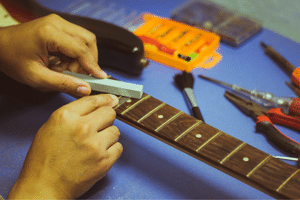
It’s great to work on your guitars, especially if you have a lot of them, but you should always be aware of your limitations.
Adjusting things like an electric guitar’s string height (action) or pickup height can be straightforward. Still, some adjustments require the proper training and experience, like adjusting a guitar’s truss rod.
However, be aware that even small adjustments or modifications can change the tone or sustain of a string’s vibrato.
When you doubt your ability to adjust, repair, or modify your guitar, it’s always best to bring it to a competent guitar technician or luthier (guitar designer & builder). You can permanently damage your guitar, and it might never play and sound right again!
Making modifications to your guitar can void its manufacturer’s warranty and cause permanent damage to the instrument. Certain modifications are irreversible, so you may be stuck with them, even if you desperately want to restore the guitar to its original condition!
I learned that the hard way over the years until I did a three-year apprenticeship in a guitar repair shop. Now I have my own home workshop with the proper training and equipment to safely maintain and repair all my instruments.
Remember: “When In Doubt, Send It Out!”
Frequently Asked Questions

Here are some of the questions I get asked about guitar vibrato.
If your question does not appear here, please put it in the comments, and I will get right back to you with an answer.
Is A Whammy Bar Tremolo Or Vibrato?
A whammy bar creates a vibrato effect because it changes the pitch of the note, so you can also call it a vibrato bar. Tremolo changes the volume of the note, not the pitch.
How Does A Vibrato Bar Work?
A vibrato bar works by changing the tension of the strings. Pressing the bar down decreases the string tension and lowers the pitch of the note. Pulling up on the bar increases the sting tension and raises the note’s pitch.
Moving the bar up and down in an alternate motion is what produces the vibrato effect.
Do Whammy Bars Make Your Guitar Go Out Of Tune?
Yes, a whammy bar can put your guitar out of tune by making the strings get bound up in the nut or slip on the tuning machine posts.
A double-locking vibrato bridge locks the strings at the bridge and the nut to help prevent the guitar from going out of tune with aggressive whammy bar use.
Is It Better To Have Fast Or Slow Vibrato?
That depends entirely on your playing style, and what goes best with the notes you’re playing. To be an expressive player, you need to learn to play vibrato fast, slow, narrow, and wide.
Are Guitar Vibrato Exercises Helpful?
Yes, the more you practice bending the guitar strings and doing vibrato, the better you will become. However, it can take years to master vibrato, even with daily practice!
Is Electric Guitar Vibrato Easier Than On Acoustic Guitar?
Vibrato is generally easier to play on an electric guitar because the thinner strings are easier to bend. It’s also possible to put light gauge strings on an acoustic guitar, but they are considerably thicker than some of the gauges available for electric instruments.
Final Thoughts

Vibrato changes the pitch (frequency) of a note or chord by making it rise up and drop down.
But how does your guitar affect vibrato playing? Your guitar’s string gauge, neck, body, electronics, hardware, and setup can all make a difference in the way you execute vibrato and change its tone and sustain.
Players most commonly notice a difference in vibrato when switching from one guitar to another. However, changing the string gauge or adjusting the vibrato bridge height are other common reasons a guitar’s vibrato can feel or sound different.
Adjusting things like pickup selection and the volume & tone controls can have a minor effect on vibrato.
To find an instrument that feels and sounds best with your style of vibrato, it’s important to play different types of guitars through a variety of amplifiers and effects pedals until you find what works right for you.
Even with the right guitar, it can take many years to master vibrato. However, vibrato is one of the most important things that define a player’s unique sound, so it’s definitely worth the effort!

Related Article ➡ Does Vibrato Increase Sustain? Make Your Solo Sound Awesome!
Here’s a great video by Carl Verheyen at Musician’s Institute, who shows you how string tension can affect the function of a whammy bar to give you the best note bending and vibrato.
Check it out!
Tell Me What You Think

Please leave a comment below if you enjoyed this article, have any questions about how your guitar can affect vibrato, or want to give your point of view. I will be happy to help you.
- Do you have a favorite guitar for doing vibrato? What type is it?
- What part of a guitar do you think affects vibrato the most?
- After reading this article, are you planing on adjusting your guitar? How?
- What else is on your mind?

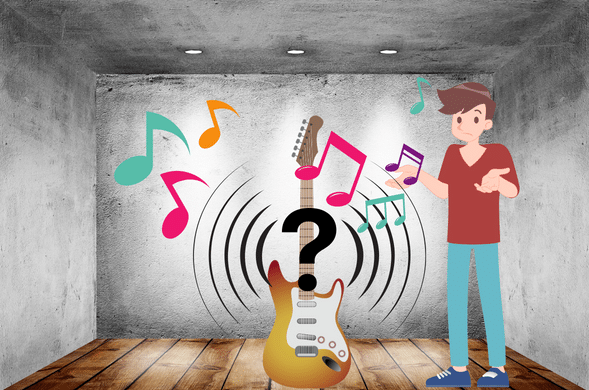

This comprehensive and easy to access article is a great help even for someone like me who plays for my own amusement and amazement. I learned to play years ago on a Vox solid body, but I wrecked that guitar. Now I have an inexpensive Yamaha. I think the tips and techniques you have offered will improve the quality of sound I make. My guitar is too inexpensive to have someone work on it so if changes need to be made, I will do it myself. I really appreciate the links in the charts you have put together. I also play the organ. The Leslie I guess is the equivalent of vibrato on a guitar. Enhancing the sound with these techniques takes practice. You article helps me know what to practice.
Jim
Hi, Jim
Thank You for your comments!
I’m thrilled that you found the article helpful!
It sounds like you’re having quite a bit of fun playing your guitar and organ. Yamaha guitars are great, even the less expensive ones!
Yeah, your Leslie rotating speaker cabinet has elements of both vibrato and tremolo since it changes the pitch and volume of the notes you play as it spins.
Rock On! 🤘
Frank 😎🎸
Vibrato playing is one of the techniques I’ve always wanted to learn since I started learning how to play guitar. Unfortunately, I was not able to because of limited time. Basically, I learned the basics of guitar playing on my own and then joined the advanced lesson conducted at our church.
I find your article very enlightening as it has given me an idea of the things to consider should I buy a new guitar and learn vibrato. By the way, I wonder if I can use my old guitar and have someone adjust i. Also, after adjusting and I want it to be adjusted back, will this affect the sound of the guitar?
Hi, Alice
Thank You for your comments!
I’m thrilled that you found the article helpful!
It’s always a good idea to learn vibrato. Electric guitar players typically use it more than acoustic players. It also depends on what type of music you play. If you’re doing folk standards, you’re not likely to use much vibrato.
If your guitar plays well, sounds good, and stays in tune, I would leave it alone. Otherwise, it’s a good idea to take it to a guitar center where they do setups and have them take a look.
Frank 🎸